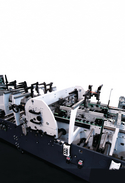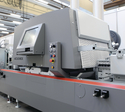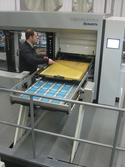Digital sees progress into post-press
2 April 2012Lynda Searby finds out how designers of post-press equipment are rising to the digital printing challenge
The digital revolution pervades nearly every aspect of life, and packaging is no exception. Digital printing of packaging isn’t yet the norm, but it is probably only a matter of time before it will be.
“We believe this will be the main market in the future; it is where we are focusing our efforts,” confirms Marcus Tralau, CEO of German firm Kama.
At present, however, packaging finishing is still distinctly analogue.
“Over the last two decades we have witnessed key areas of the supply chain becoming digital, but packaging finishing remains analogue,” says Aviv Ratzman, chief executive of Israeli firm Highcon.
He says this means converters and their customers have been unable to benefit from the speed and flexibility that digital solutions could provide to finishing.
Highcon is hoping to change this with the launch of what it claims is the world’s first entirely digital cutting and creasing machine for folded cartons.
Branded the Euclid, the machine uses Highcon’s Digital Adhesive Rule Technology (DART) to create the crease lines within minutes, without the need for traditional dies. The Euclid is equipped with multiple lasers and precision optics to deliver high quality cut and creased sheets with a format size of up to 76 x 106cm.
The ‘revolutionary kit’ will be shown at Drupa in May, and the first machine has just been installed at Israeli converting company Graphica Bezalel, where Highcon said it would dramatically cut turnaround times and make run lengths up to 10,000 sheets profitable.
This is certainly a development worthy of note, but manufacturers of conventional diecutters and folder gluers would argue that their equipment is perfectly adequate for digital print jobs.
“Some carton and corrugated makers are trialling digital, although the run speeds, and hence the productivity, can’t match conventional methods as yet. But if printers are using digital, perhaps for some short run or specialist work, our die cutter and folder gluer lines can handle the job just as easily,” says Craig Moran, sales manager for Bobst in the UK, Ireland and Scandinavia.
This doesn’t mean that suppliers of die cutting equipment have been resting on their laurels where digital printing is concerned. Kama started a joint project with Xerox and StoraEnso in 2008 to develop a digital solution for package printing. This resulted in the launch of Gallop – a production line for short runs and individualised packs incorporating Kama’s DC 58 inline die cutter.
In the same year, Kama presented the world’s first flat-bed die cutter for A3 format, the ProCut 53, with features that Kama says make it very suitable for short digital runs. Kama says it has achieved this in a number of ways: a strong press section reduces the need for time-consuming patch-up, and the smaller format helps too.
It is possible to change over die cutting jobs in less than five minutes and to change from hot foil stamping to diecutting in 10 minutes. “Even small and personalised runs can be carried out economically and finished in the highest quality,” says Marcus Tralau.
Since then, Kama has engineered several further advancements to make its diecutters more compatible with digital presses. One issue it has addressed is that of registration accuracy.
“The demands of the packaging industry are very high – supermarkets want all cartons to look exactly the same,” says Tralau. “Digital printing processes are not as accurate as offset printing, so we have developed an AutoRegister system that aligns every sheet to a printing mark. With this we can balance out register variations.”
Kama has also worked together with AB Graphics to incorporate varnishing into the post-press unit. “In an offset process, varnishing is included in the press, but in digital, it is another step,” explains Tralau.
Kama has developed a web solution to this issue, and at Drupa 2012 will be showing how it can now carry out varnishing and die-cutting in one step for digitally printed sheets too.
The advent of digital printing is by no means the only factor driving innovation in diecutting kit – decreasing run lengths and a cut-throat commercial climate mean anything that squeezes more productivity out of equipment is going to be of interest to the industry.
At Drupa 2012, Heidelberg will be unveiling several developments aimed at enhancing machine performance and reducing makeready times, including the Dymatrix 106 Pro with a new automatic chase changer.
“This speeds up the exchange of different cutting dies considerably and extends the die cutter’s extensive level of automation,” explains Paul Thompson, packaging conversion specialist with Heidelberg UK.
The company is also launching its new B2 format die cutter, the Varimatrix 82 CS, which it claims is ideal for packaging printers who have to produce ever shorter runs and meet extremely short delivery times. The diecutter promises to boost productivity through a combination of high cutting force for its class, speeds of up to 8,000 sheets per hour and user-friendly operation.
For companies using hand-fed platens in particular, operator safety is paramount. Diecut UK says it has been working for over two years to develop a replacement for the hand-fed platen that can not only cut every type of substrate that can be cut on a hand-fed platen, but also completely protects the person operating it.
Branded the Diecut UK Goldline, the new manual diecutting system is billed as ‘the biggest development in over 90 years of manual diecutters’. The first machine is currently being installed at a London-based commercial printer.
Folder gluing
In-line inspection of blanks is often carried out on the folder gluer. To this end, Bobst has launched what it claims is the world’s first built-in zero-fault quality control device for folding and gluing machines. Using a high definition camera, the Accucheck scans each carton as it enters the folder gluer, comparing the real-time image against a reference image.
“The really hot area in packaging at the moment is finding ways of ensuring the quality of the product you send out – so that manufacturers can deliver the zero fault packaging brand owners are demanding,” says Bobst’s Craig Moran.
Heidelberg, meanwhile, has developed Inspection Control for its Diana X folding carton gluing machine. It says fitting Inspection Control inline means that every carton is verified and compared to the master sample set via prepress or entered manually into the system.
“This facility, with automatic ejection, adds to the security of packaging, reduces waste and improves customer satisfaction levels,” says Thompson.
Manufacturers of folder gluing equipment have also had to respond to a change in EU legislation which requires all pharmaceutical packaging to carry Braille.
Heidelberg’s answer is a Braille unit that sits on the folder gluer immediately after the alignment station and prior to any other process, meaning that the positioning is exact. It is a male-female method using an etched brass plate or steel plate, punched to create the raised image. Even with the Braille unit running, Heidelberg says the Diana X can still operate at speeds of over 100,000 cartons per hour.
In March, Falconer Print & Packaging became the first company in the UK to take delivery of a Diana X folder gluer with a Braille unit. Until now, Falconer has produced Braille in the diecutting section of its production facility and says the tooling costs to produce Braille this way are very expensive. The company hopes that running Braille on the Diana X will be considerably more cost effective.
Laser cutting a ‘natural fit for digital’
Laser cutting is becoming an increasingly attractive option to label converters, owing to its promise of a speedy return on investment, according to Mike Bacon, VP sales and marketing with Spartanics.
Speed, quality and cost have deterred some label printers from using laser cutting. However, Bacon says new software technology that soft-marks has eliminated quality concerns and in terms of speed, Spartanics’ systems average 60-70m/min, though speeds can be as high as 100m/min, depending on the thickness of the material and size of the label.
Spartanics is also working to close the cost gap with flexo systems, and has just launched the L350 (350mm) and L210 (210mm) for around US$300,000 – comparable to the price tag of a flexo machine. But even if laser cutters are slightly more expensive to buy, the savings on tooling (there are no tooling costs with a laser cutter) can produce a return on investment in one to two-and-a-half years.
Other benefits include a reduction in scrap material waste during job set-up and changeover.
Spartanics has recently integrated its laser cutter with a narrow web digital printer and predicts that within the next two years, many digital print press manufacturers will be offering integrated solutions.
“Laser cutting is a natural fit for digital printing,” says Bacon. “Both are lean manufacturing practices where waste is minimised. Printers simply have to take a single print file and send it to both machines.”
Laser cutting could also be an interesting proposition for packaging converters, as tooling is expensive and runs are ever-decreasing. Indeed, Spartanics was recently asked by a European company to build a dual-headed sheet laser for cutting boxes.
“The issue with laser cutting cartons is the thickness of the material – the more material you have to burn away, the quicker you have to remove the debris from the laser chamber so that it doesn’t settle back onto the product,” explains Bacon.
To this end, Spartanics has developed a belt cleaning system and vacuum belt to cut against so that the sheet is stable during the cutting process.
Bobst Accucheck Bobst Accucheck Bobst's Craig Moran Bobst's Craig Moran Heidelberg's Paul Thompson Heidelberg's Paul Thompson Heidelberg Diana Inspection Control Diana Inspection Control Heidelberg Diana Braille Diana Braille Heidelberg Dymatrix Dymatrix Spartanics L350 Spartanics L350 Highcon Euclid Highcon Euclid









